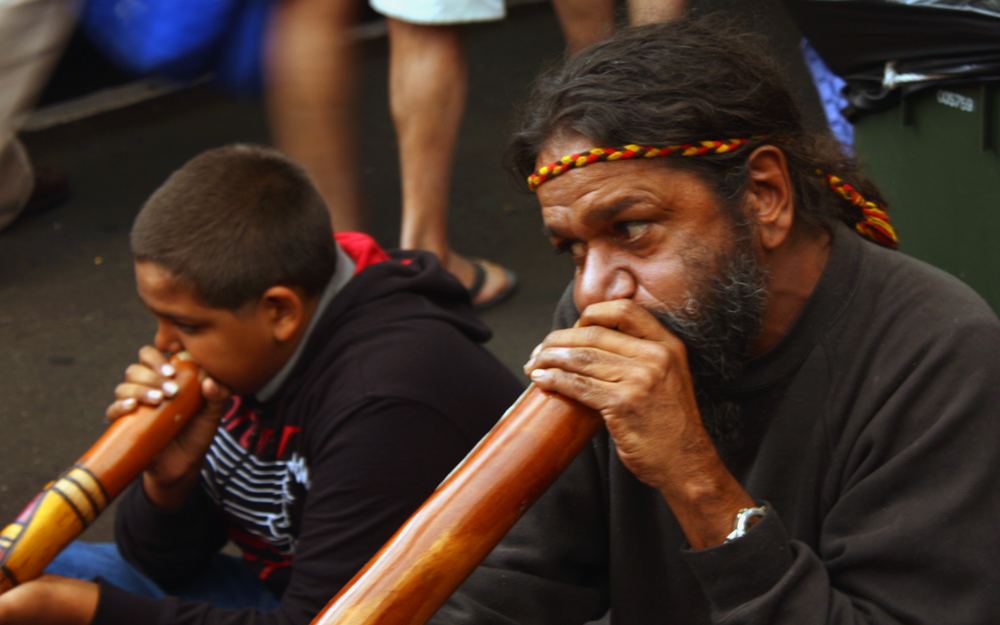|
Prehistoric Music
Prehistoric music (previously called primitive music) is a term in the history of music for all music produced in preliterate cultures (prehistory), beginning somewhere in very late geological history. Prehistoric music is followed by ancient music in different parts of the world, but still exists in isolated areas. However, it is more common to refer to the "prehistoric" music which still survives as folk, indigenous or traditional music. Prehistoric music is studied alongside other periods within music archaeology. Findings from Paleolithic archaeology sites suggest that prehistoric people used carving and piercing tools to create instruments. Archeologists have found Paleolithic flutes carved from bones in which lateral holes have been pierced. The disputed Divje Babe flute, carved from a cave bear femur, is thought to be at least 40,000 years old. Instruments such as the seven-holed flute and various types of stringed instruments, such as the Ravanahatha, have been recovered f ... [...More Info...] [...Related Items...] OR: [Wikipedia] [Google] [Baidu] |
History Of Music
Although definitions of music vary wildly throughout the world, every known culture partakes in it, and it is thus considered a cultural universal. The origins of music remain highly contentious; commentators often relate it to the origin of language, with much disagreement surrounding whether music arose before, after or simultaneously with language. Many theories have been proposed by scholars from a wide range of disciplines, though none have achieved broad approval. Most cultures have their own mythical origins concerning the invention of music, generally rooted in their respective mythological, religious or philosophical beliefs. The music of prehistoric cultures is first firmly dated to BP of the Upper Paleolithic by evidence of bone flutes, though it remains unclear whether or not the actual origins lie in the earlier Middle Paleolithic period (300,000 to 50,000 BP). There is little known about prehistoric music, with traces mainly limited to some simple ... [...More Info...] [...Related Items...] OR: [Wikipedia] [Google] [Baidu] |
Archaeology
Archaeology or archeology is the scientific study of human activity through the recovery and analysis of material culture. The archaeological record consists of artifacts, architecture, biofacts or ecofacts, sites, and cultural landscapes. Archaeology can be considered both a social science and a branch of the humanities. It is usually considered an independent academic discipline, but may also be classified as part of anthropology (in North America – the four-field approach), history or geography. Archaeologists study human prehistory and history, from the development of the first stone tools at Lomekwi in East Africa 3.3 million years ago up until recent decades. Archaeology is distinct from palaeontology, which is the study of fossil remains. Archaeology is particularly important for learning about prehistoric societies, for which, by definition, there are no written records. Prehistory includes over 99% of the human past, from the Paleolithic until the adven ... [...More Info...] [...Related Items...] OR: [Wikipedia] [Google] [Baidu] |
Yawn
A yawn is a reflex lasting 4-7 seconds, and is characterized by a long inspiratory phase with gradual mouth gaping, followed by a brief climax (or acme) with muscle stretching, and a rapid expiratory phase with muscle relaxation. For fish and birds, this is described as gradual mouth gaping, staying open for at least 3 seconds and subsequently a rapid closure of the mouth. Almost all vertebrate animals, including mammals, birds, reptiles, amphibians, and even fish, experience yawning. The study of yawning is called chasmology. Yawning (oscitation) most often occurs in adults immediately before and after sleep, during tedious activities and as a result of its contagious quality. It is commonly associated with tiredness, stress, sleepiness, boredom, or even hunger. In humans, yawning is often triggered by the perception that others are yawning (for example, seeing a person yawning, or talking to someone on the phone who is yawning). This is a typical example of positive feedb ... [...More Info...] [...Related Items...] OR: [Wikipedia] [Google] [Baidu] |
Cough
A cough is a sudden expulsion of air through the large breathing passages that can help clear them of fluids, irritants, foreign particles and microbes. As a protective reflex, coughing can be repetitive with the cough reflex following three phases: an inhalation, a forced exhalation against a closed glottis, and a violent release of air from the lungs following opening of the glottis, usually accompanied by a distinctive sound. Frequent coughing usually indicates the presence of a disease. Many viruses and bacteria benefit, from an evolutionary perspective, by causing the host to cough, which helps to spread the disease to new hosts. Most of the time, irregular coughing is caused by a respiratory tract infection but can also be triggered by choking, smoking, air pollution, asthma, gastroesophageal reflux disease, post-nasal drip, chronic bronchitis, lung tumors, heart failure and medications such as angiotensin-converting-enzyme inhibitors (ACE inhibitors). Treatment should t ... [...More Info...] [...Related Items...] OR: [Wikipedia] [Google] [Baidu] |
Click Consonant
Click consonants, or clicks, are speech sounds that occur as consonants in many languages of Southern Africa and in three languages of East Africa. Examples familiar to English-speakers are the '' tut-tut'' (British spelling) or '' tsk! tsk!'' (American spelling) used to express disapproval or pity, the '' tchick!'' used to spur on a horse, and the '' clip-clop!'' sound children make with their tongue to imitate a horse trotting. Anatomically, clicks are obstruents articulated with two closures (points of contact) in the mouth, one forward and one at the back. The enclosed pocket of air is rarefied by a sucking action of the tongue (in technical terminology, clicks have a lingual ingressive airstream mechanism). The forward closure is then released,This is the case for all clicks used as consonants in words. Paralinguistically, however, there are other methods of making clicks: ''under'' the tongue or as above but by releasing the rear occlusion first. See #Places of articul ... [...More Info...] [...Related Items...] OR: [Wikipedia] [Google] [Baidu] |
Whistling
Whistling without the use of an artificial whistle is achieved by creating a small opening with one's lips, usually after applying moisture (licking one's lips or placing water upon them) and then blowing or sucking air through the space. The air is moderated by the lips, curled tongue, teeth or fingers (placed over the mouth or in various areas between pursed lips) to create turbulence, and the curled tongue acts as a resonant chamber to enhance the resulting sound by acting as a type of Helmholtz resonator. By moving the various parts of the lips, fingers, tongue and epiglottis, one can then manipulate the types of whistles produced. Techniques Pucker whistling is the most common form in much Western music. Typically, the tongue tip is lowered, often placed behind the lower teeth, and pitch altered by varying the position of the tongue. Although varying the degree of pucker will change the pitch of a pucker whistle, expert pucker whistlers will generally only make small varia ... [...More Info...] [...Related Items...] OR: [Wikipedia] [Google] [Baidu] |
Hum (sound)
A hum is a sound made by producing a wordless tone with the mouth closed, forcing the sound to emerge from the nose. To hum is to produce such a sound, often with a melody. It is also associated with Speech disfluency#Thoughtful absorption, thoughtful absorption, Speech disfluency#"Hmm", 'hmm'. A hum has a particular timbre (or sound quality), usually a Monophony, monotone or with slightly varying frequency, tones. There are other similar sounds not produced by human singing that are also called hums, as the sound produced by machinery in operation, such as a Microwave oven, microwave, or by an insect in flight. The hummingbird was named for the sound that bird makes in flight which sounds like a hum. Mechanics A 'hum' or 'humming' by humans is created by the resonance of air in various parts of passages in the head and throat, in the act of breathing. The 'hum' that a hummingbird creates is also created by resonance: in this case by air resistance against wings in the actio ... [...More Info...] [...Related Items...] OR: [Wikipedia] [Google] [Baidu] |
Singing
Singing is the act of creating musical sounds with the voice. A person who sings is called a singer, artist or vocalist (in jazz and/or popular music). Singers perform music (arias, recitatives, songs, etc.) that can be sung with or without accompaniment by musical instruments. Singing is often done in an ensemble of musicians, such as a choir. Singers may perform as soloists or accompanied by anything from a single instrument (as in art song or some jazz styles) up to a symphony orchestra or big band. Different singing styles include art music such as opera and Chinese opera, Indian music, Japanese music, and religious music styles such as gospel, traditional music styles, world music, jazz, blues, ghazal, and popular music styles such as pop, rock, and electronic dance music. Singing can be formal or informal, arranged, or improvised. It may be done as a form of religious devotion, as a hobby, as a source of pleasure, comfort, or ritual as part of music education or ... [...More Info...] [...Related Items...] OR: [Wikipedia] [Google] [Baidu] |
Human Voice
The human voice consists of sound made by a human being using the vocal tract, including talking, singing, laughing, crying, screaming, shouting, humming or yelling. The human voice frequency is specifically a part of human sound production in which the vocal folds (vocal cords) are the primary sound source. (Other sound production mechanisms produced from the same general area of the body involve the production of unvoiced consonants, clicks, whistling and whispering.) Generally speaking, the mechanism for generating the human voice can be subdivided into three parts; the lungs, the vocal folds within the larynx (voice box), and the articulators. The lungs, the "pump" must produce adequate airflow and air pressure to vibrate vocal folds. The vocal folds (vocal cords) then vibrate to use airflow from the lungs to create audible pulses that form the laryngeal sound source. The muscles of the larynx adjust the length and tension of the vocal folds to 'fine-tune' pitch and ... [...More Info...] [...Related Items...] OR: [Wikipedia] [Google] [Baidu] |
Musical Instrument
A musical instrument is a device created or adapted to make musical sounds. In principle, any object that produces sound can be considered a musical instrument—it is through purpose that the object becomes a musical instrument. A person who plays a musical instrument is known as an instrumentalist. The history of musical instruments dates to the beginnings of human culture. Early musical instruments may have been used for rituals, such as a horn to signal success on the hunt, or a drum in a religious ceremony. Cultures eventually developed composition and performance of melodies for entertainment. Musical instruments evolved in step with changing applications and technologies. The date and origin of the first device considered a musical instrument is disputed. The oldest object that some scholars refer to as a musical instrument, a simple flute, dates back as far as 50,000 - 60,000 years. Some consensus dates early flutes to about 40,000 years ago. However, most historians be ... [...More Info...] [...Related Items...] OR: [Wikipedia] [Google] [Baidu] |
Imitation Of Sounds In Shamanism
Shamanism in various cultures shows great diversity.Hoppál 2005: 15 In some cultures, shamanic music may intentionally mimic natural sounds, sometimes with onomatopoeia.Hoppál 2006: 143 Imitation of natural sounds may also serve other functions not necessarily related to shamanism, such as luring in the hunt;Nattiez: 5 and entertainment (s of the ).Nattiez: 5 [...More Info...] [...Related Items...] OR: [Wikipedia] [Google] [Baidu] |
Sound Mimesis In Various Cultures
The imitation of natural sounds in various cultures is a diverse phenomenon and can fill in various functions. In several instances, it is related to the belief system (yoiks of the Sami,Szomjas-Schiffert 1996: 56, 76Szomjas-Schiffert 1996: 64Somby 1995 Szomjas-Schiffert 1996: 74 some other shamanic songs and rituals,Diószegi 1960: 203Hoppál 2005: 92 /ref> of some cultures). It may serve also such practical goals as luring in the hunt; or entertainment ( |


.jpg)




.jpg)

